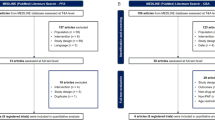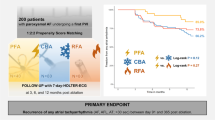Abstract
The development of pulmonary vein stenosis has recently been described after radiofrequency ablation (RF) to treat atrial fibrillation (AF). The purpose of this study was to examine expression of TGFβ1 in pulmonary vein stenosis after radiofrequency ablation in chronic atrial fibrillation of dogs. About 28 mongrel dogs were randomly assigned to the sham-operated group (n = 7), the AF group (n = 7), AF + RF group (n = 7), and RF group (n = 7). In AF or AF + RF groups, dogs underwent chronic pulmonary vein (PV) pacing to induce sustained AF. RF application was applied around the PVs until electrical activity was eliminated. Histological assessment of pulmonary veins was performed using hematoxylin and eosin staining; TGFβ1 gene expression in pulmonary veins was examined by RT-PCR analysis; expression of TGFβ1 protein in pulmonary veins was assessed by Western blot analysis. Rapid pacing from the left superior pulmonary vein (LSPV) induced sustained AF in AF group and AF + RF group. Pulmonary vein ablation terminated the chronic atrial fibrillation in dogs. Histological examination revealed necrotic tissues in various stages of collagen replacement, intimal thickening, and cartilaginous metaplasia with chondroblasts and chondroclasts. Compared with sham-operated and AF group, TGFβ1 gene and protein expressions was increased in AF + RF or RF groups. It was concluded that TGFβ1 might be associated with pulmonary vein stenosis after radiofrequency ablation in chronic atrial fibrillation of dogs.



Similar content being viewed by others
References
Kannel WB, Wolf PA, Benjamin EJ, Levy D (1998) Prevalence, incidence, prognosis, and predisposing conditions for atrial fibrillation: population-based estimates. Am J Cardiol 82:2N–9N
Greenbaum RA, Campbell TJ, Channer KS (1998) Conversion of atrial fibrillation and maintenance of sinus rhythm by dofetilide. Circulation 17(suppl):1633
Park Angela M, Chou Chung-Chuan, Drury Paul C, Okuyama Yuji, Peter Anish, Hamabe Akira, Miyauchi Yasushi, Kass Robert M, Karagueuzian Hrayr S, Fishbein Michael C, Lin Shien-Fong, Chen Peng-Sheng (2004) Thoracic vein ablation terminates chronic atrial fibrillation in dogs. Am J Physiol Heart Circ Physiol 286:H2072–H2077
Taylor Gregg W, Neal Kay G, Zheng Xiangsheng, Bishop Sanford, Ideker Raymond E (2000) Pathological effects of extensive radiofrequency energy applications in the pulmonary veins in dogs. Circulation 101:1736–1742
Jeziorska M (2001) Transforming growth factor-betas and CD105 expression in calcification and bone formation in human atherosclerotic lesions. Z Kardiol 90(Suppl. 3):23–26
Kumagai K, Khrestian C, Waldo AL (1997) Simultaneous multisite mapping studies during induced atrial fibrillation in the sterile pericarditis model. Insights into the mechanism of its maintenance. Circulation 95:511–521
Wu TJ, Ong JJC, Chang CM, Doshi RN, Yashima M, Huang HLA, Fishbein MC, Ting CT, Karagueuzian HS, Chen PS (2001) Pulmonary veins and ligament of Marshall as sources of rapid activations in a canine model of sustained atrial fibrillation. Circulation 103:1157–1163
Morillo CA, Klein GJ, Jones DL, Guiraudon CM (1995) Chronic rapid atrial pacing. Structural, functional, and electrophysiological characteristics of a new model of sustained atrial fibrillation. Circulation 91:1588–1595
Haissaguerre M, Jais P, Shah DC, Takahashi A, Hocini M, Quiniou G, Garrigue S, Mouroux AL, Me´tayer PL, Cle´menty J (1998) Spontaneous initiation of atrial fibrillation by ectopic beats originating in the pulmonary veins. N Engl J Med 339:659–666
Zhou S, Chang CM, Wu TJ, Miyauchi Y, Okuyama Y, Hamabe A, Omichi C, Hayashi H, Brodsky LA, Mandel WJ, Ting CT, Fishbein MC, Karagueuzian HS, Chen PS (2002) Nonreentrant focal activations in pulmonary veins in canine model of sustained atrial fibrillation. Am J Physiol Heart Circ Physiol 283:H1244–H1252
Wijffels MC, Kirchhof CJ, Dorland R, Allessie MA (1995) Atrial fibrillation begets atrial fibrillation. A study in awake chronically instrumented goats. Circulation 92:1954–1968
Author information
Authors and Affiliations
Corresponding author
Additional information
Shufeng Li and Hongli Li contributed equally to the work.
Rights and permissions
About this article
Cite this article
Li, S., Li, H., Mingyan, E. et al. Expression of TGFβ1 in pulmonary vein stenosis after radiofrequency ablation in chronic atrial fibrillation of dogs. Mol Biol Rep 36, 221–225 (2009). https://doi.org/10.1007/s11033-007-9170-7
Received:
Accepted:
Published:
Issue Date:
DOI: https://doi.org/10.1007/s11033-007-9170-7




